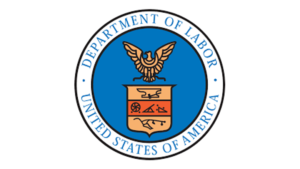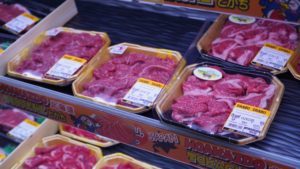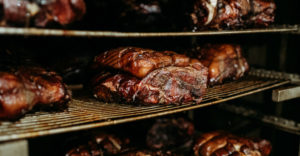KANSAS CITY, Mo. — In 1984, the hamburger chain Wendy’s launched an ad campaign featuring the question, “Where’s the beef?” The campaign turned the querier, a Russian-born, American octogenarian manicurist named Clara Peller, into a megastar for the last three years of her life.
Just shy of 40 years later, the animal ag industry is confronting a much more serious question: Where is the sustainable beef?
It’s not an easy question to answer. But it is a crucial one as producers struggle to repel attacks by anti-animal ag activists while simultaneously striving to feed both America and the world.
And as April’s annual conference on Climate-Smart Animal Agriculture by the National Institute for Animal Agriculture made readily clear, the animal ag industry is putting a lot of thought into the question of sustainability. More important, the animal agriculture industry is turning its discussions on sustainability into action across all segments, from beef to pork, veal, mutton, and more.
“We’ve received great feedback from attendees saying there wasn’t a session where they didn’t learn something worth taking back to the workplace,” said J.J. Jones, NIAA executive director.
Next up for NIAA is the 13th annual Antibiotics Symposium in Atlanta in November.
Country of origin labeling
A quarter century ago, country of origin labeling was a controversial issue. But today, labeling involves a lot more information for consumers — and a lot more work for producers. And it is helpful in an era when consumers are demanding more information about where their food comes from.
In the U.S, for example, COOL requires specificity on where the animal was born, raised, and slaughtered. According to the Agricultural Marketing Service of the U.S. Department of Agriculture, a label for meat in America could say “Born, Raised and Slaughtered in the U.S.” Or it could say “Born in Mexico, Raised and Slaughtered in the U.S.”
But now, consumers and even restaurants and retailers want more, more, more.
In her keynote address, Anne-Marie Roerink of 210 Analytics, told attendees of the Climate-Smart Animal Agriculture Conference that producers are feeling the pressure from consumers who want details about the origins of their food. They also are feeling pressure from restaurants, retailers, and other end users to cut carbon emissions and reduce land and water use — and to prove both their methods and results in sustainability efforts.
Of course, there’s a catch: There is no universal definition for what is “sustainable.”
It’s no longer just recycling garbage or adding solar power panels. It’s increasingly also including greenhouse gas emissions and efforts to reduce them. It also is including antibiotic use and animal welfare practices like reducing how many animals are raised in a given acreage or whether animals are “free range” or “grass-fed”
“We know that antibiotic use is starting to show up on labels, and we want to explore what this means for animal agriculture,” said Eric Moore of Norbrook Inc. and chairman of the NIAA board.
Consumer purchasing trends
Roerink said it also is increasingly important to understand consumer meat purchasing habits and the reasons consumers elect to buy — or not buy — meat. She acknowledged that there are meat alternatives, but she said that sales of meat alternatives are overwhelmingly dwarfed by traditional meat sales.
“But we have to consider consumer attitudes, and we have to address them,” Roerink said. “Do people feel good about meat and poultry in their diet? Seventy-four percent say yes. That’s not the worst, but it could be better. And there is a shocking difference in attitudes of younger people versus older. Only 64% of younger people said they feel good about beef in their diet versus 77% of older people.”
The top five factors that consumers say now influence their beef purchasing decisions are:
- cost
- health concerns
- animal welfare
- social responsibility
- medical advice
“Sixty-seven percent of consumers want to know where their food comes from,” Roerink said. “The beef industry is already taking positive steps toward sustainability, but consumers don’t know it. And the pressure continues for meat producers. In some places in Europe, for example, retailers are not allowed to even advertise beef. Countries like Switzerland and Germany have tier-rating systems for meat. In the UK, at the shelf, there are animal welfare ratings on meat.”
Consumers “have no clue” as to what ‘Net Carbon Zero’ is, said Roerink, referring to a supply chain practice that shows how much carbon is generated through each product’s supply chain. The goal, then, is to reduce carbon emissions and to document how that is accomplished. In many cases, that includes reaching out to the suppliers that producers source feed and other things in order to understand the carbon footprints for the entire supply chain.
“There is a big opportunity to convince consumers that the meat they have access to is both safe and healthy,” said Roerink, who is a native of The Netherlands. “But it’s not enough just to make claims. We have to define what sustainability means to us. We have to reduce our carbon emissions. And we have to document it.”

And research is showing that upstream suppliers to the animal agriculture industry are major contributors to that producer’s supply chain greenhouse gas emissions.
For example, “more than 50% of greenhouse gas emissions in pork comes from feed growing,” said Billy Gascoigne of Ducks Unlimited, a sportsman’s organization that works extensively with farmers nationwide to preserve and protect wetlands
That’s why it is increasingly important to work with the entire supply chain to identify sustainability problems and reach solutions, speakers at the conference said. There are many questions that the animal agriculture industry has to come together to answer as a whole.
“For example, what is air-cooled chicken? What is regenerative agriculture? What does organic mean? What does grass-fed mean?” Roerink said. “We’re seeing more and more signage at retail explaining meat. White meat vs. dark. Bone-in vs. bone-out. Organic vs. traditional. And we’re seeing more people calling out hormone usage and antibiotics. These questions can cause people to change what meat they buy, how they buy it, and even if they buy it.”
Ryan Goodman of Certified Angus Beef, said it is not enough for individual companies to pursue their own definition of ‘sustainability.’ He said animal agriculture as a whole needs to generate a definition of ‘sustainability’ and to communicate it together to consumers.
“All of us in animal ag are doing things in sustainability, but we’re not talking to each other,” Goodman said. “So consumers are getting mixed messages. As an industry we need to define what ‘sustainability’ is. We need, as an industry, to identify ways to reach Net Carbon Zero, and then we need to implement them. And then we have to explain to consumers how we are doing this.”
And the animal ag industry is just getting started.
“Only 10 of the 96 members of the National Institute for Animal Agriculture have definitions of ‘sustainability’ online. And many of those definitions differ from each other,” said Josh Luth of SCS Global Services. “We aren’t on the same page yet with our definitions. This is a complex issue, and we have to speak in one voice.”
As a result, it’s easy for consumers to get confused or to become influenced by other definitions of ‘sustainability’ that don’t reflect what the animal agriculture industry is doing.
“Our goal in animal ag is to produce safe and nutritious food,” said Kaitlyn Briggs of Dairy Management Inc. “Four in five consumers are familiar with sustainability in general. But only two out of three consumers are familiar with ‘sustainable agriculture.’”
Goodman agreed. “We have to speak about sustainability in one language. We have to make sure we are using the terms that consumers around the world will understand. We can’t leave this just to corporate reports.”
Paul Hishmesh of Field to Market agreed, saying, “The definition of ‘sustainability’ is changing as climate changes and technology advances. Ten years ago in agriculture, we were arguing about whether the climate was even changing. We were arguing over whether using solar panels would make us sustainable. But now we realize that sustainability is about so much more than solar panels. Today, to reduce carbon footprints, we’re moving from carbon-based fuels to EVs (electric vehicles).”
Ellen Lai of ABS Global said the faster that animal agriculture concentrates around one definition of ‘sustainability’ the better.
“Setting goals is not enough,” she said. “We have to implement solutions, and the solutions have to be scalable. And we have to include producers in the conversation, and it has to be a conversation, not a lecture.”
So if defining ‘sustainability’ is important, what will that definition include?
A major issue that will have to be included in any definition of “sustainability” is water use and water rights.
Much of the area where large animal agricultural farms exist are experiencing severe drought conditions that are compounding the problem of how water rights are awarded, said Gascoigne of Ducks Unlimited.
Burke Griggs of Washington University, agreed. A key question is are we pumping more groundwater than returns to the system? This leads to depletion of an aquifer. In Kansas, which has the third-largest number of cattle on ranches and feedyards in America, the beef cattle sector is the biggest part of the state’s agricultural production, according to the state’s department of agriculture. And that is threatened by drought and aquifer depletion in most of the state, a problem whose origins can be traced back to water rights reorganization more than 40 years ago, Griggs said.
Anti-microbial resistance also is an increasingly important topic that should be included in sustainability definitions and development, many speakers agreed.
“The 1977 and 1990 farm bills similarly defined “sustainability” said event closing keynote speaker Steve Swaffer of the Noble Research Institute.
“Sustainability is the status quo,” Swaffer said. “But ‘Climate Smart’ is where we’re headed, and ‘Climate Smart’ is sort of like ‘Sustainability +.’
There are a lot of parts to ‘Climate Smart’ and the sustainability efforts in animal agriculture, no matter what the name, Swaffer said. Events like the NIAA’s Climate-Smart conference will continue to bring more voices to the table and more information to refine animal agriculture production in the future, he said.
The marketer who came up with the “Where’s the Beef?” slogan probably had no idea the commercials and spokesperson Peller would touch Americans so positively and powerfully. Forty years later, the important question of “how was the beef produced” is one that is bringing all of animal agriculture together.





Report Abusive Comment